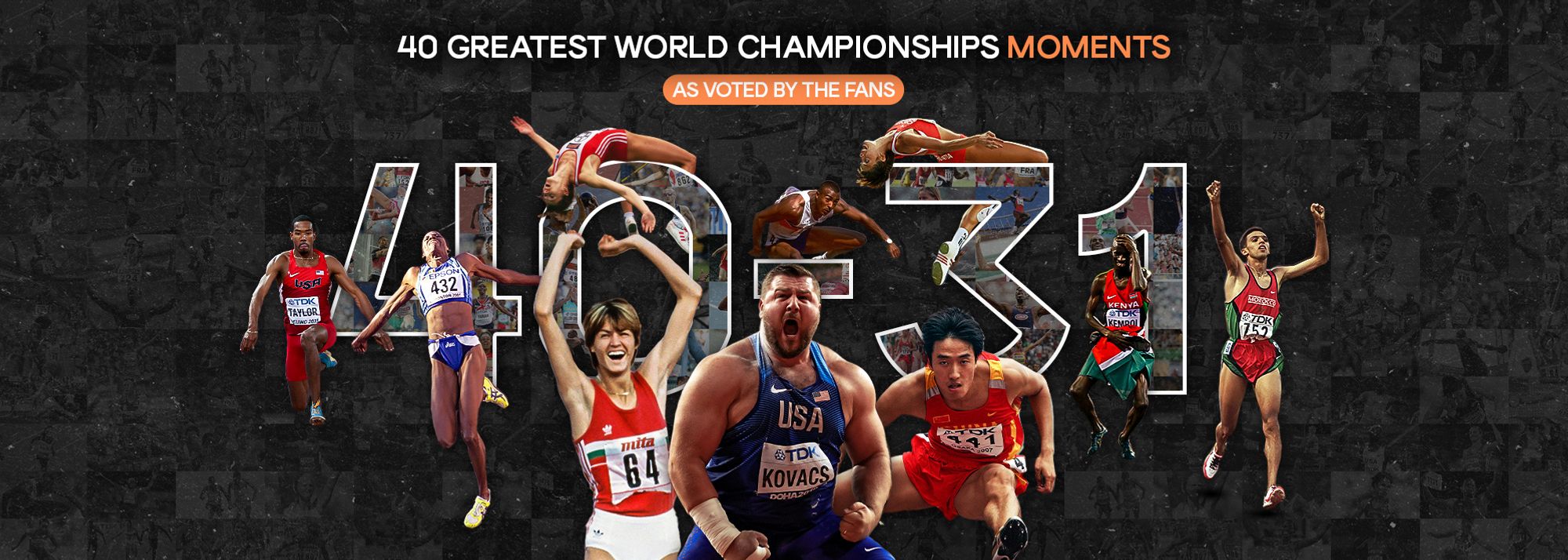Greatest World Championships moments - 40 to 31
To mark the 40th anniversary of the World Athletics Championships, fans from all around the world were asked to vote for the greatest moments from the past four decades of championship action.
Thousands of fans took part, and the votes have now been counted, so it is time to begin the countdown of the 40 greatest World Championships moments – as decided by followers of the sport.
Twenty different countries from all six continental areas are represented in the top 40. Moments from all 18 past editions of the World Championships feature in the countdown.
The next instalment of the countdown will be published on 6 July, and the following 10 moments will be revealed on 13 July, with the final top 10 being announced on 19 July.
But now, without further ado, the countdown begins with moments 40 to 31.
40 – El Guerrouj bounces back from Olympic disappointment to win first world title (1997, Athens)
Hicham El Guerrouj emerged as a serious middle-distance contender in the mid-1990s. He won world indoor gold and world silver over 1500m in 1995, then enjoyed a highly successful 1996 campaign in which he won all of his races – apart from in the Olympic final, where he tripped and fell, his Olympic dreams in tatters.
But 1997 brought with it a chance for redemption in the form of the World Championships in Athens. And the Moroccan runner this time made sure there wouldn’t be a repeat of what happened in Atlanta.
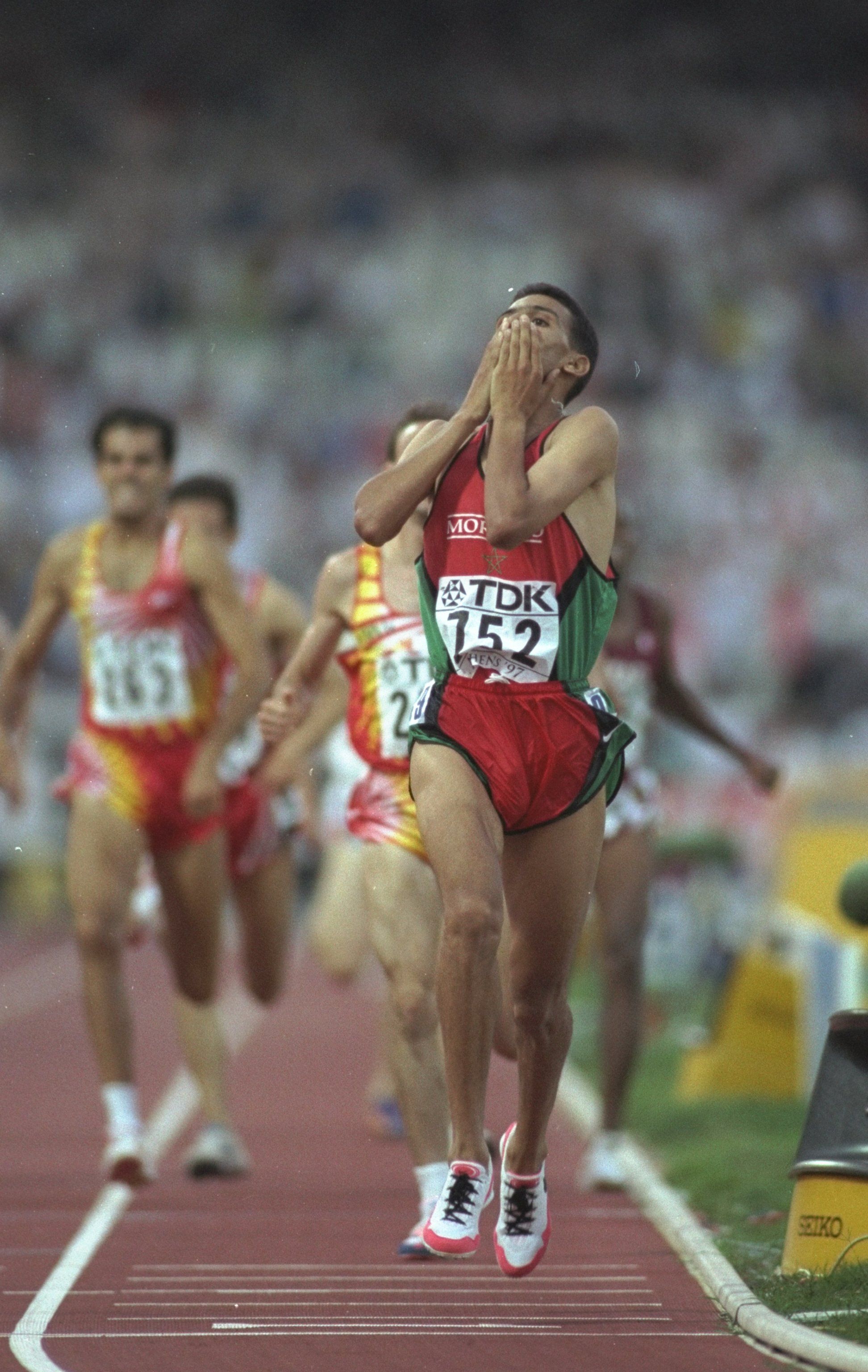
Hicham El Guerrouj wins the world 1500m title in Athens (© Getty Images)
It was a tactical – and, by El Guerrouj’s standards, slow – race with three-time world champion Noureddine Morceli tracking the Moroccan for most of the way. 1992 Olympic champion Fermin Cacho and fellow Spaniard Reyes Estevez adopted some team tactics to boost their medal chances, but they couldn’t compete with the finishing speed of El Guerrouj, who sprinted clear in the closing stages to win by almost a second in 3:35.83.
It was the first of four outdoor world titles that Guerrouj won during a glittering career that also included double Olympic gold in 2004.
39 – Kemboi wins fourth world steeplechase title, leading Kenyan sweep (2015, Beijing)
In many ways, the men’s steeplechase final at the 2015 World Championships in Beijing was a classic sit-and-kick race – which once again played into the hands of Ezekiel Kemboi.
The Kenyan was reluctant to run at the front of the pack for most of the way, but he remained in contention throughout and was still in touch with the leaders when the kicking started heading into the last lap.

Ezekiel Kemboi wins the steeplechase at the IAAF World Championships, Beijing 2015 (© Getty Images)
Kemboi’s teammates Conseslus Kipruto, Brimin Kipruto and Jairus Birech were all in the medal hunt, as were USA’s Evan Jager and Algeria’s Brahim Taleb. Kemboi put in a burst of speed with just over half a lap to go, breezing to the front of the pack. Kipruto tried to stick with him in the closing stages, but stuttered over the final barrier and could only look on as Kemboi strode to victory in 8:11.28.
It was Kemboi’s fourth world title in succession, having also won in 2009, 2011 and 2013. He also led a historic 1-2-3-4 finish for Kenya – the first time one country has filled the top four places in the steeplechase at the World Championships.
38 – Kovacs prevails in epic three-way shot put clash (2019, Doha)
Just when it seemed as though the men’s shot put title at the 2019 World Championships was heading in one direction, things took a turn. And then another. And another…
Ryan Crouser set the tone with the opening effort of the night, throwing 22.36m to break the championship record which had stood at 22.23m for 32 years. But defending champion Tom Walsh, who was last in the throwing order, made an even bigger splash at the end of that round.
The New Zealander landed a monster throw of 22.90m to smash his lifetime best and Oceanian record, as well as the championship record that Crouser had established just moments earlier. The farthest throw in the world for 29 years, it also elevated Walsh to fourth on the world all-time list.
Brazil’s Darlan Romani entered the fray in the second round, throwing 22.53m – also surpassing the pre-event championship record – to move into second place. Romani stayed in that position until the fourth round, when Crouser improved to 22.71m – just three centimetres shy of his PB at that time.
Walsh continued to lead – relatively comfortably – going into the final round, and it seemed as though he would retain his title. But then Joe Kovacs stepped into the ring.
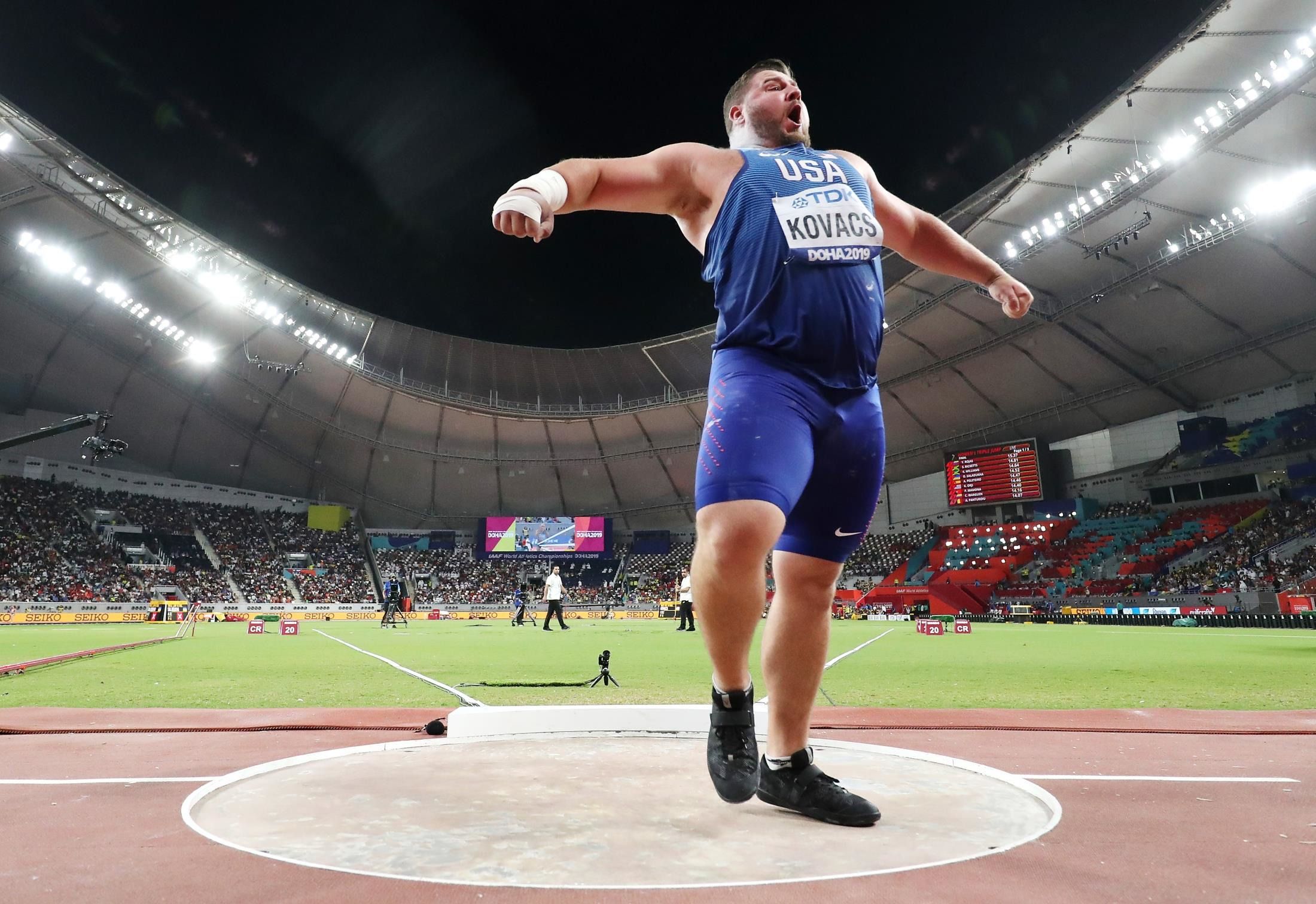
Joe Kovacs after unleashing his winning throw at the IAAF World Athletics Championships Doha 2019 (© Getty Images)
The 2015 world champion was sitting in fourth place, but hadn’t thrown beyond 22 metres in the final up until that point and seemed to be out of the medal hunt. But he then unleashed a mammoth throw right down the centre of the sector. Before his shot even hit the grass, Kovacs started roaring in celebration, knowing he had landed a good one.
Moments later, it was measured at an astonishing 22.91m – enough to take the lead by a centimetre.
Romani – having just been bumped out of a medal finish – was next to throw, but the Brazilian didn’t improve.
Crouser was next into the ring. The Olympic champion produced a throw that landed well beyond the 22-metre line. Staggeringly, it was measured at 22.90m – the exact same distance as Walsh’s opening effort, but Crouser’s next-best effort was enough to give him second place on countback ahead of the kiwi thrower.
Walsh took one final throw, and it was another huge effort, but he stepped outside of the ring and so didn’t improve upon his third-place position.
By the end of the final, the top four finishers had thrown well beyond the previous championship record, and the three medallists – all of whom smashed their PBs – were separated by one centimetre. And Kovacs had regained the world title he won four years prior.
Before these World Championships, there had been no additions to the top six on the world all-time list for almost 30 years. But after the incredibly high standard final in Doha, Kovacs (fourth), Crouser and Walsh (equal sixth) all moved near the top of that list.
37 – Henkel produces perfect scorecard to dominate high jump (1991, Tokyo)
A close contest between two or three athletes is always enthralling. But sometimes pure dominance by a single performer can be just as mesmerising to witness.
In fact, Germany’s Heike Henkel didn’t dominate the high jump at just the 1991 World Championships; she had been the no.1 high jumper in the world for the entire season, winning 18 of her 19 competitions.
Her scorecard at the World Championships in Tokyo mirrored her season as a whole: near perfection.
She opened with 1.87m then sailed over 1.93m. She was the only athlete to clear 1.98m at the first time of asking. Yelena Yelesina got over it on her second try, but would go no higher.
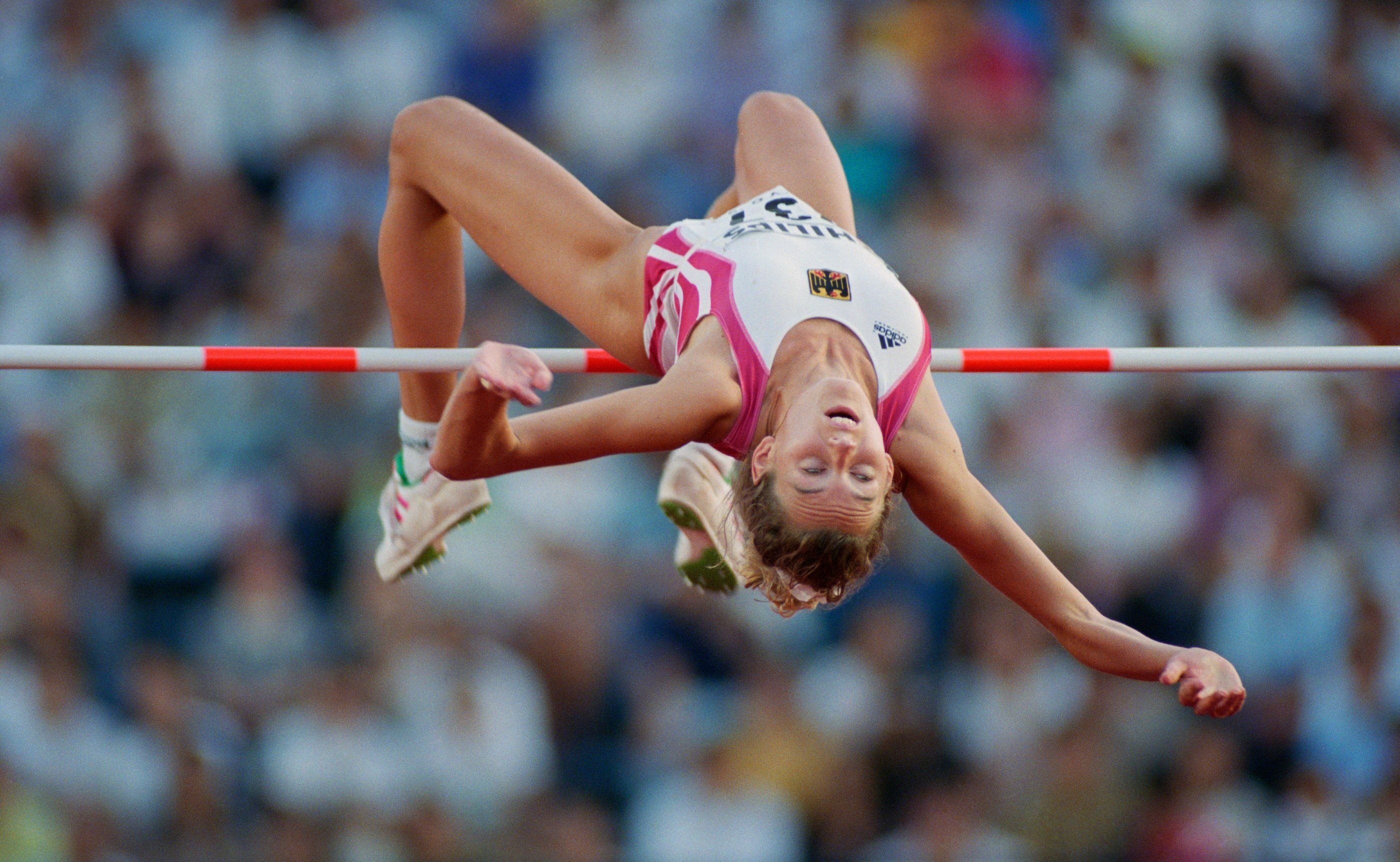
Heike Henkel of Germany at the 1991 World Athletics Championships in Tokyo (© Getty Images)
Henkel, meanwhile, went on to clear 2.00m, 2.02m and a national record of 2.05m – all on her first jumps.
Her only failed attempts were at her final height of 2.07m, but by that point she had done more than enough to win gold.
Her winning margin of seven centimetres remains the best ever at a World Championships.
36 – May rebounds from Seville surprise to win close long jump battle (2001, Edmonton)
For almost the entire women’s long jump final at the 1999 World Championships in Seville, it looked as though Fiona May would regain the world title she had earned four years prior.
The Italian had led from the opening round with a 6.92m leap, improving to 6.94m in round three. But, much to the delight of the home crowd, Spain’s Niurka Montalvo uncorked a national record of 7.06m in the last round to take the lead.
When the replay flashed up on the screen, however, May questioned the official’s judgement on the validity of the jump because the front of Montalvo’s shoe appeared incredibly close to the plasticine. Despite an appeal from the Italian team, the result stood.
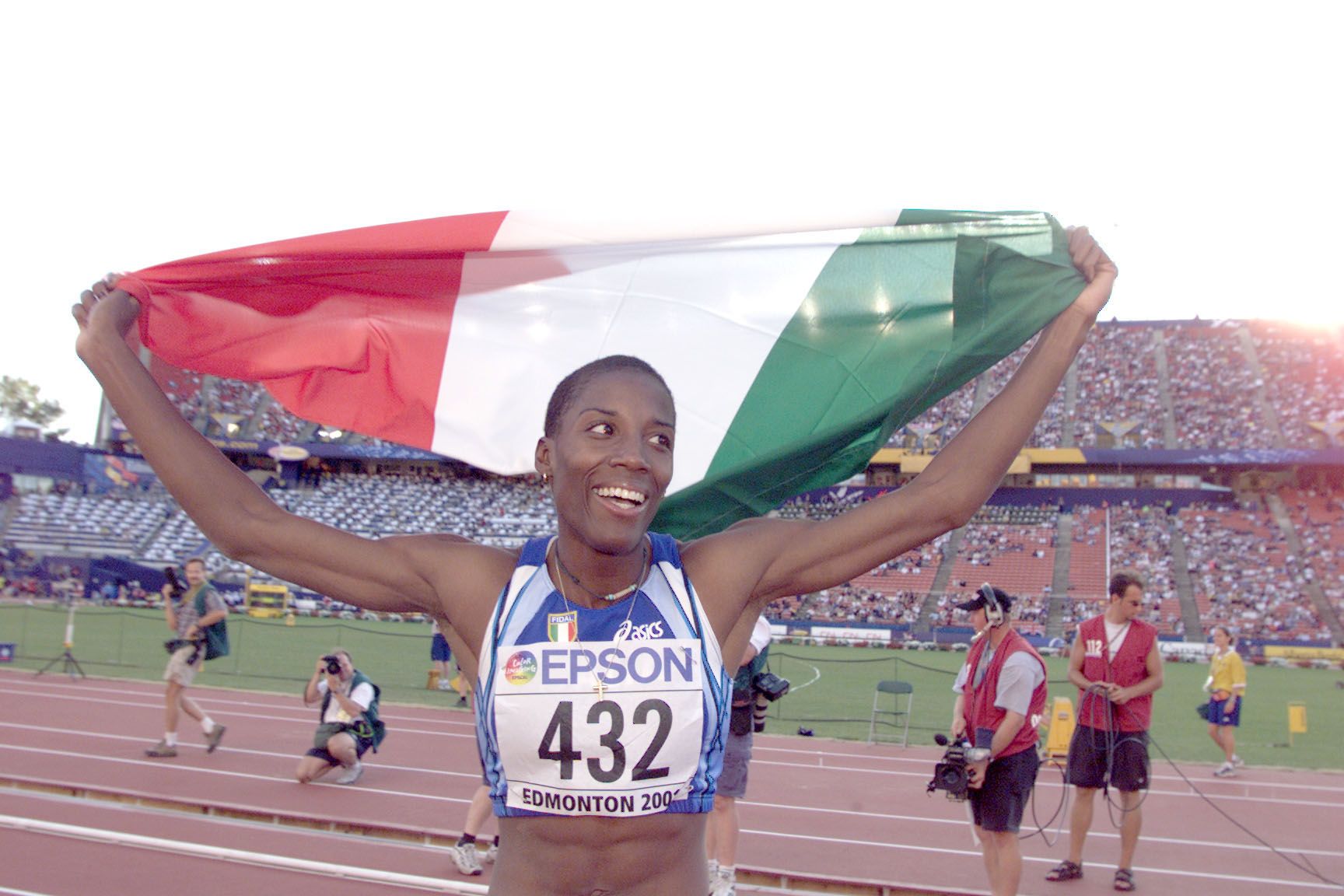
Fiona May after winning the 2001 world long jump title (© Getty Images)
It was doubly disappointing for May, whose final-round leap – one that could have potentially moved her up from third place – at the 1997 World Championships was ruled a foul.
But in 2001, May enjoyed her moment of glory – and redemption – at the World Championships in Edmonton. Once again, she led from round one (6.86m) before improving to 6.97m in round two. She went even farther in the third round, leaping 7.02m.
For a brief moment it looked as though May’s lead would be taken, as Russia’s Tatyana Kotova landed a fourth-round jump around the seven-metre line. But it was measured at 7.01m and May held on to her lead until the final round.
35 – Taylor threatens world triple jump record (2015, Beijing)
In 2015, triple jumpers Christian Taylor and Pedro Pablo Pichardo had duelled all season long.
Pichardo got the upper hand in their first clash of the year, leaping a PB of 18.06m to Taylor’s 18.04m at the Diamond League meeting in Doha. It was the first time two men had surpassed 18 metres in the same competition.
Taylor then equalled Pichardo’s world-leading mark of 18.06m to win in Lausanne with his Cuban rival finishing just seven centimetres in arrears. Taylor also won their clash in Monaco eight days later, winning by just two centimetres.
Going into the World Championships in Beijing, it was too close between the pair to predict how the final would play out.
Sure enough, it was close. For most of the competition, anyway.

Christian Taylor in the triple jump final at the IAAF World Championships Beijing 2015 (© Getty images)
Pichardo took an early lead with 17.52m, but Taylor came close to it with 17.49m in round two. Both men then jumped the exact same distance in round three, 17.60m, but Pichardo held the advantage on countback.
Taylor then moved into the lead with 17.68m in the fourth round, while Pichardo responded with another 17.52m leap in round five.
With his final attempt of the competition, Taylor produced the best jump of his life – and, indeed, the second-best jump in history – sailing out to 18.21m. Pichardo, the last man to jump in the competition, ended with his best leap of the day, but his 17.73m was nowhere near enough to get the better of Taylor.
34 – Jackson breaks world 110m hurdles record (1993, Stuttgart)
The fact that Colin Jackson won the 1993 world 110m hurdles title was no big surprise; the Briton had dominated the event all season and went into the World Championships in Stuttgart with an unbeaten record outdoors.
But his winning time, however – a world record of 12.91 – is what made his victory stand out as one of the moments of the championships.
He had previously won a handful of titles at the European and Commonwealth level, but he had yet to land a global title. He was third at the 1987 World Championships, second at the 1988 Olympics and withdrew from the 1991 World Championships. He was also fourth at the 1987 World Indoors and second at the 1989 and 1993 editions.
To say he was keen to win a senior global honour would be an understatement.
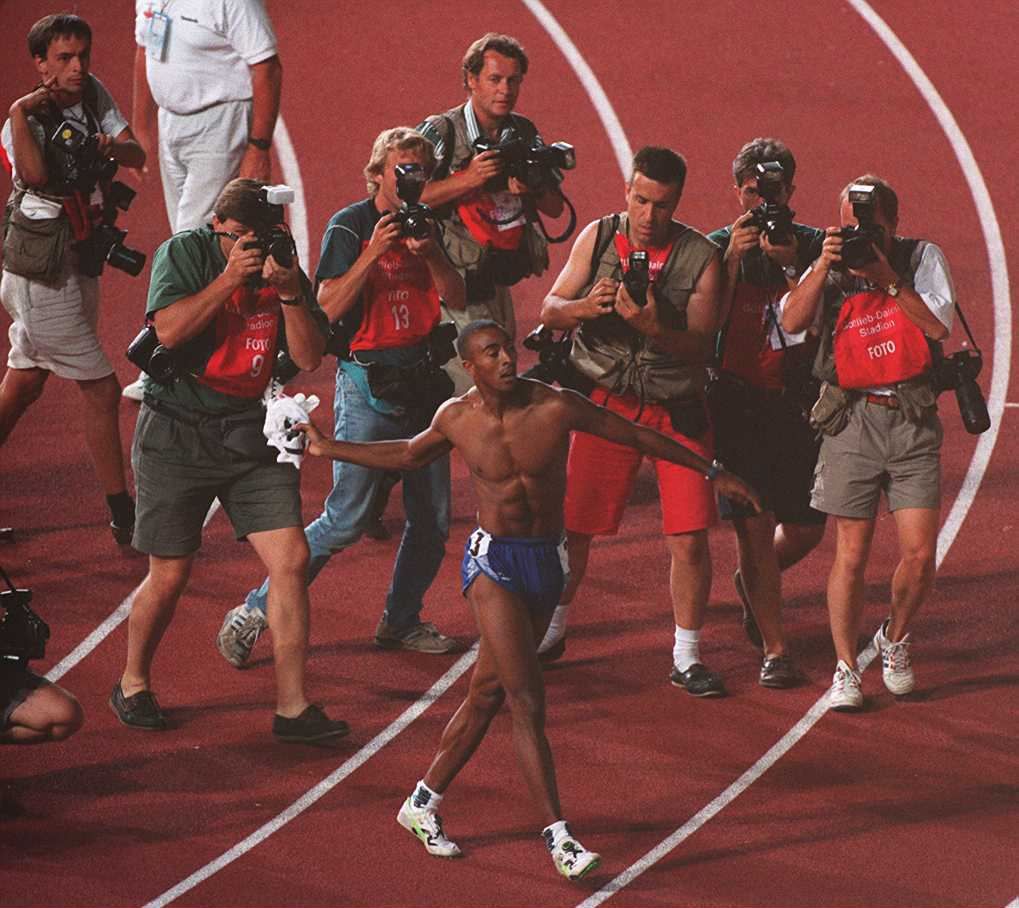
Colin Jackson after winning the 1993 world 110m hurdles title in a world record (© Getty Images)
That moment finally came on 20 August 1993 when he put together the race of his life to win 110m hurdles gold in 12.91, taking 0.01 off the world record that had been set by USA’s Roger Kingdom four years prior.
Jackson’s time remained the world record for 13 years. After being equalled by Liu Xiang in 2004, the Chinese sprint hurdler finally broke the mark in 2006 with 12.88.
33 – Liu takes hurdles gold from lane nine (2007, Osaka)
Speaking of Liu Xiang, the hurdles supremo was more than just a record-breaker.
After winning Olympic gold in 2004 and becoming a sporting superstar in China, he won his second global title in 2007 at the World Championships in Osaka.
It didn’t come easy, though.
He finished second in his semifinal and was just fifth fastest overall to advance to the final. As a result of that, he was in the bottom half of the lane draw and had to make do with lane number nine.
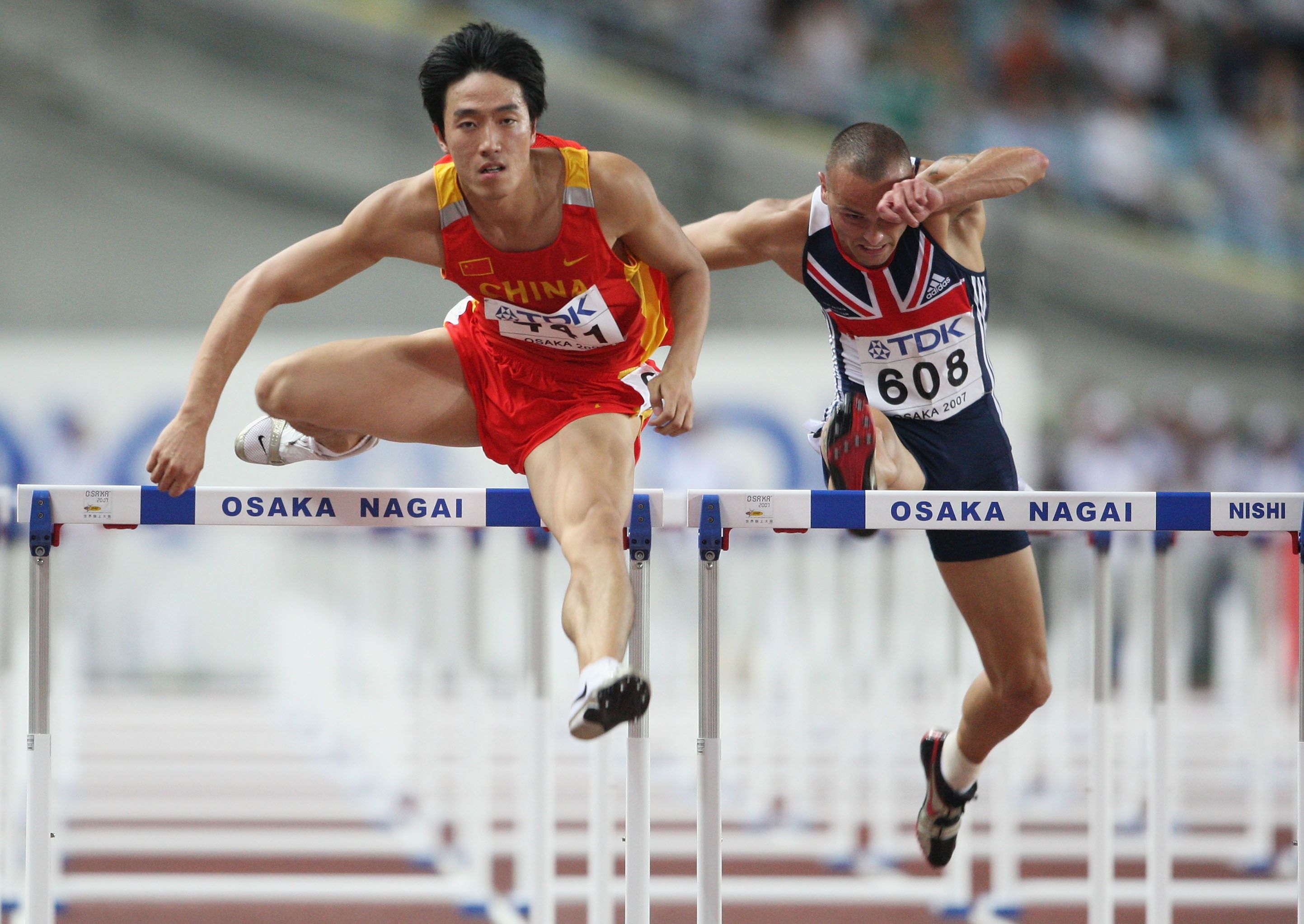
Liu Xiang in action at the 2007 World Championships in Osaka (© Getty Images)
USA’s Terrence Trammell got off to a strong start and seemed to be leading for most of the way. But, despite being distanced from the other big contenders, Liu managed to run his own race and came through to take gold in 12.95 with Trammell earning silver in 12.99.
USA’s David Payne, who only arrived in Osaka the day before the event began, having been a reserve, took bronze in 13.02.
32 – Vlasic triumphs in high jump showdown (2009, Berlin)
It had been billed as one of the big clashes of the championships, and it didn’t disappoint.
Blanka Vlasic had established herself as the world’s best high jumper, winning world titles indoors and out, and consistently jumping over two metres.
But in 2008 a new challenger emerged in the form of Ariane Friedrich. The German even managed to beat Vlasic towards the end of that season, then started 2009 in even better form.
What’s more, is that the World Championships that year were being held in Friedrich’s home country.
Friedrich racked up three more victories over Vlasic in the first half of 2009, including at the ISTAF meeting in Berlin, where she cleared a world-leading PB of 2.06m. The meeting was also held in the same stadium that would host the World Championships two months later. For Friedrich, it seemed like a good omen.
Vlasic gained revenge in their final clash before the World Championships, winning on countback with 2.03m in Monaco. The scene was set for another great duel in Berlin.
Both women had a clean scorecard up to and including 1.99m, putting them in joint first place at that point. What made it more enthralling is that the two women had contrasting approaches: while Vlasic thrived off the crowd’s energy, Friedrich instead preferred to jump in complete silence. And, as the home crowd favourite, she was able to command that each time she jumped.
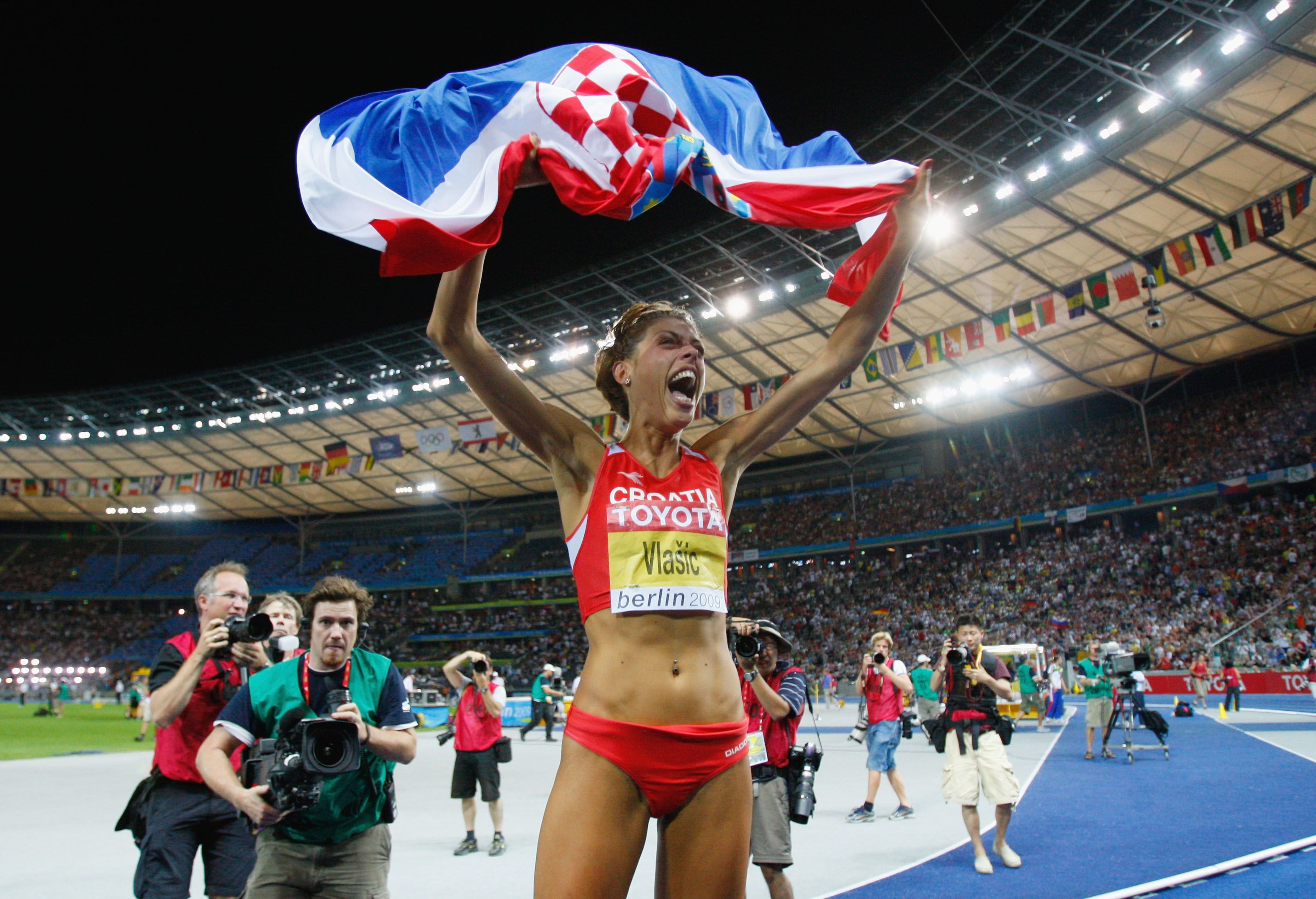
Blanka Vlasic wins the 2009 world high jump title in Berlin (© Getty Images)
At the next height, though, a spanner was thrown into the works in the form of Anna Chicherova. The Russian cleared 2.02m on her first attempt to take the lead, while Vlasic needed two tries and Friedrich required three.
The bar then moved to 2.04m and Vlasic was the first to clear, giving the Croatian the sole lead. Chicherova missed all three of her attempts, while Friedrich brought the bar down on her first two tries. With Vlasic having cleared 2.04m, Friedrich’s only option of gaining the lead was to move the bar to 2.06m. She did that, but once again knocked down the bar.
Gold went to Vlasic and bronze went to Friedrich, but it was later upgraded to silver after Chicherova’s disqualification for a doping ban.
31 – Kostadinova breaks world high jump record (1987, Rome)
To say Stefka Kostadinova was the overwhelming favourite to win the high jump at the 1987 World Championships in Rome would be putting it mildly.
The Bulgarian had twice broken the world record one year prior. She had also won 21 of her 22 competitions in 1987 before the World Championships, including victories at the World Indoor Championships and European Indoor Championships.
But as the high jump final reached the business end in the Italian capital, it seemed as though Kostadinova was about to suffer a shock defeat.
She had cleared all heights on her first try up to and including 2.02m. But so too had Tamara Bykova of the Soviet Union. Bykova then cleared 2.04m on her first attempt, while Kostadinova missed on her first try. And then again on her second.

Stefka Kostadinova, winner of the high jump at the 1987 IAAF World Championships in Rome (© Getty Images)
She had one jump remaining to stay in the competition. Luckily for the Bulgarian, she went clear. She was then successful at 2.06m, while Bykova missed her first two tries and then had one more miss at 2.08m.
With gold now secured and the pressure off, Kostadinova raised the bar to 2.09m. Her first attempt was a miss, but she nailed the perfect jump on her second try, setting a world record that still stands.

